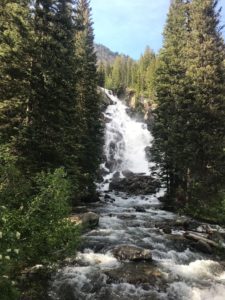In Unforgettable Bits and Pieces: How Three National Parks Stole My Heart

This summer took me to three of the nation’s natural treasures: Great Smoky Mountains, Grand Teton, and Isle Royale National Parks. Three completely different parts of the country, and each stole a bit of my heart. Let me give you just a glimpse of them!
Great Smoky Mountains National Park spans into Tennessee, North Carolina, and Georgia. The mountains roll across the horizon, sheltering herds of calving elk and smatterings of turkey, as well as a dense population of troublesome black bears. Everyone in the Smokies hopes to see one! They won’t be disappointed. The bears crush through the underbrush, noses sniffing out picnic table lunches, unlocked cars, and trash bins. While I was lucky enough to see one bear, poking its head out of the leaves just across the street, I got even luckier with a winning opportunity to attend the annual Firefly Viewing Event.
The mating ritual of the synchronous firefly: a once-in-a-lifetime light show
Photinus carolinus is one of a few synchronous firefly species. Each June, the males signal females in the leaf litter with their blink-blink-blink-blink-blink-paauuuse pattern. Their 5-8 blinks and 8-second return to darkness helps the females recognize their own species, so they don’t become dinner for other illuminated imposters flitting through the mating grounds.

It wasn’t the whole forest of fireflies blinking as one like I’d imagined. Instead, small, localized groups of them blinked away without rhythm. But then they fell silent all at the same time, winking back into darkness before starting up again. It felt otherworldly, like something you might see in the depths of the ocean where creatures must make their own light if they ever want to see any.
Not an afterthought, Grand Teton is bold and humbling
Fast forward to July. Grand Teton is hot. Everyone here looks for moose instead of black bears. And moose do abound—sometimes straight out of the trees in front of your car.

Many visitors come to Grand Teton as an afterthought, tacked on to visits to Yellowstone. But Grand Teton is stunning, big, and breathtaking, the rugged 40-mile Teton Mountain Range serving as centerpiece and focus of the park, snow still icing its peaks. That striking landscape is humbling; consider the forces of nature that created it, the plates of the earth shoving the rocks of Grand Teton Peak to preside over Jackson Hole Valley, 13,775 feet above sea level.

My group and I decided to hike around Jenny Lake to get to Hidden Falls rather than take the shuttle boat. We spotted what I’m sure was an American marten—my first! It was quite the contrast to see such a shy species just minutes from the top of a waterfall where a man pulled out his phone to share the view over FaceTime.

Grand Teton National Park teems with adventures: Floating and fishing the Snake River, imagining it as Ansel Adams might have seen it; hikes long and short to waterfalls and alpine lakes; overlooks with the best views lining the roads through the park; historical buildings and stories of both the area’s Native American Tribes and early European settlers.
Isle Royale Is So Wild
Little known, sparsely visited. Almost 100% wilderness. No FaceTiming from the top of your hike here—or almost anywhere on the island. That is the magic of Isle Royale.
I happily tromped along the island’s trails and shoreline, listening for loons and snatching glimpses of Canada through the trees and across the ocean-like water, my unserviceable phone blissfully forgotten. Every time I spotted moose droppings I remembered one man’s warning prior to my trip:
“You will see moose, and you will see wolves. And be prepared for black flies!”

The island is possibly most famous for the long-term predator-prey research involving its populations of moose, beaver, and gray wolves. The 20 or so miles of Lake Superior separating Isle Royale from mainland Minnesota has created an ideal opportunity for studying these interactions between hunter and hunted. There are just 19 mammal species on the island. The wolf is the only apex predator and has three main sources of food: snowshoe hare, beaver, and moose. So, few wildlife species and fewer people simplifies the island’s web of life. It’s easier to see nuances in connections and relationships between species. These discoveries are not only applicable on-island but can inform predator-prey relationships in other ecosystems as well.

It’s not actually very common to see any of the wolves living on Isle Royale. I didn’t see any. Or moose, for that matter, and the black flies stayed blessedly away.
And now here I am, back cozy at home in Montana, wondering when I’ll be able to go again, to backpack across Isle Royale, bike through Grand Teton, and hike to all the waterfalls in the Smokies, looking for those little pieces of my heart that escaped me there—or, more realistically, simply leaving more behind.
The post In Unforgettable Bits and Pieces: How Three National Parks Stole My Heart appeared first on The National Wildlife Federation Blog.
Source: Public Lands
Originally Posted on NWF.org




